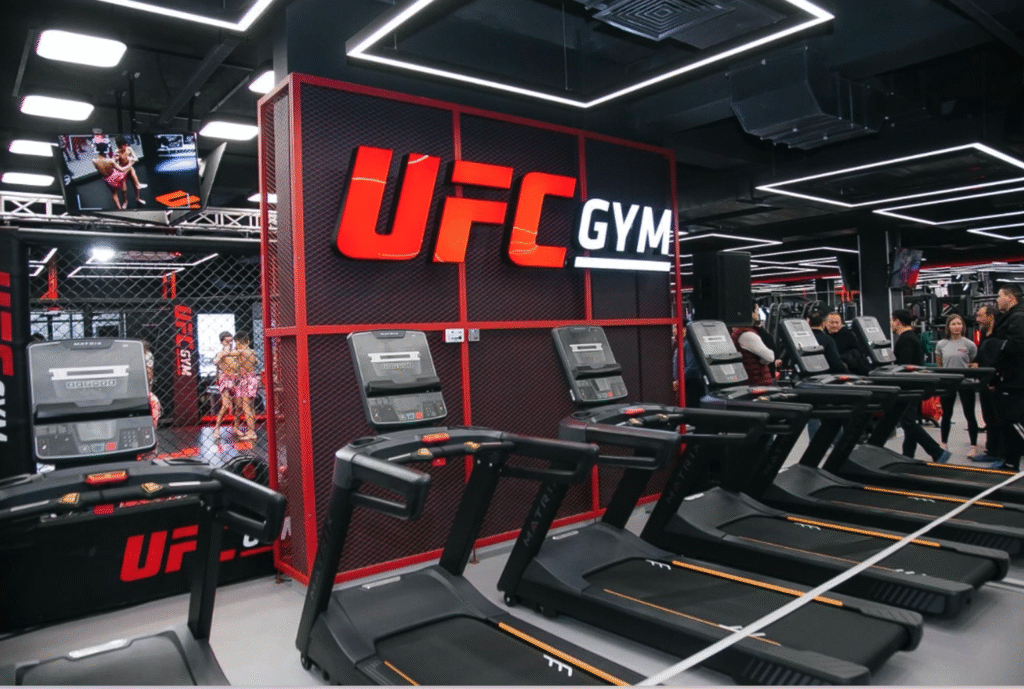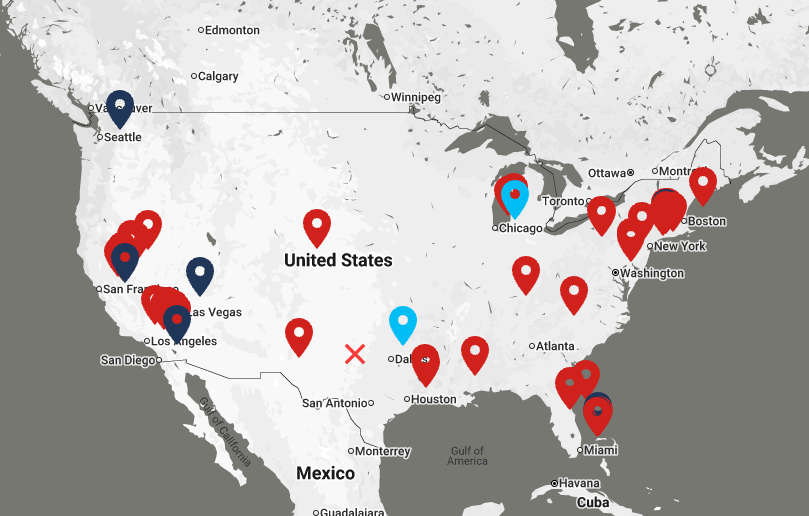UFC Gym Franchise Review
Overview of Costs, Profit Potential, and What Owners Say
UFC Gym broke into the fitness world with a simple idea: bring mixed martial arts-inspired training to everyone, not just fighters. Backed by the power and fame of the UFC brand, these gyms grabbed attention with their unique classes and tough, supportive community. Now, UFC Gym has opened doors for entrepreneurs to run their own locations through franchising.
People are asking if this is a smart bet in a world full of fitness options. In this review, you’ll get a no-nonsense look at the UFC Gym franchise. We’ll walk through the business side, industry trends, and what real owners say so you can make a confident choice.
Disclosure: our content is reader-supported, which means we may earn commissions from links at no cost to you.
Overview of UFC Gym Franchise Model
Looking at UFC Gym as a business opportunity means stepping into a brand with serious name recognition and a fresh take on fitness. UFC Gym combines a pro-fighting image with programs designed for everyday people. If you’re interested in what this franchise model is all about, here’s how it works and why so many fitness fans are paying attention.
The UFC Brand and Its Appeal
The UFC name carries weight. It’s not just for hardcore fight fans; it’s become a pop culture heavyweight. UFC Gyms use this to their advantage. The brand signals strength, grit, and transformation. When new members walk through the door, they know what to expect: high energy, team spirit, and authentic MMA roots.

Key reasons the UFC name draws members and franchise owners:
- Instant Recognition: UFC is globally known, so there’s no mystery around what the gym is about.
- Trust Factor: Members expect high standards from anything with the UFC stamp.
- Community Vibe: UFC Gyms promote the idea that everyone, from total beginners to pro-level athletes, belongs here. No intimidation, just support.
Types of Facilities and Services
UFC Gym franchises don’t use a one-size-fits-all approach. There are different business models, each tuned for different communities and investment sizes:
- Full-Size UFC Gym: The flagship clubs. These can be 15,000 square feet or bigger. They offer everything under one roof including an octagon, full strength and cardio areas, recovery zones, and locker rooms.
- Class Studios (UFC FIT and CLASS): Smaller, more focused clubs. These centers zero in on group fitness, quick sessions, and basic strength or cardio. They often fit better in urban spaces or busy retail areas.
- UFC Gym Jiu Jitsu: The smallest boutique gym with a focus on Brazilian Jiu Jitsu. It offers classes for adults and youth for striking, fitness, and grappling in 3,000 square feet. The investment requirement is the lowest for this type, but hinges heavily on the presence of black belt coaching.
No matter the club size, most locations provide:
- MMA-style group fitness classes
- Boxing and kickboxing areas
- Personal training
- Kids’ and family programs
- Strength training
- Recovery programs like stretching, physical therapy, and sometimes even cryotherapy
This flexible format means franchisees can pick the model that matches their ambition and local demand.
Initial Investment and Startup Costs
Before opening a UFC Gym, every future owner wants the real numbers. The investment depends on the format. Opening a full flagship gym requires a bigger budget than a boutique studio. UFC Gym provides a range for total investment, which includes fees, equipment, construction, and operating capital.
Typical cost breakdown:
- Franchise Fee: This is the upfront price to use the UFC Gym name. Expect a fee starting at $40,000 for most formats.
- Build-Out and Equipment: Designing the gym, getting MMA cages, fitness gear, and branding the club can cost anywhere from $500,000 to over $2 million, depending on size.
- Other Costs: Working capital, insurance, local permits, and marketing add to the startup total.
Most new owners should plan for an initial outlay anywhere between $300,000 for a small format studio and up to $2.5 million for a large, flagship facility. UFC Gym offers support with location selection, build-out, training, and pre-opening marketing to help owners get going as quickly as possible. Financial requirements and ability to secure funding will play a key role in how fast you can open your gym.
Financial Performance and Franchisee Support
Before getting into the nuts and bolts of daily operations, you need to know what kind of money you can make, what it’ll really cost over time, and how much help you’ll get along the way. The UFC Gym franchise isn’t just about selling workouts; it’s about building a business that has the power of a global brand behind it. In this section, you’ll find out where your money comes from, where it goes, and how UFC Gym works to set up franchisees for long-term success.
Revenue Streams and Earning Potential
UFC Gym franchises are built on several income sources, not just memberships. This helps owners avoid putting all their eggs in one basket and can make monthly income more stable. Here’s what powers the cash flow:
- Monthly Memberships: The main revenue driver. Members pay for access to classes, equipment, and gym space. Pricing depends on location, club size, and service tier.
- Group Fitness and Specialty Classes: High-energy group workouts like boxing, kickboxing, HIIT, and youth programs bring in extra fees and keep people coming back.
- Personal Training: Trainers offer one-on-one or small group sessions. These not only boost gym results for members but can have strong profit margins.
- Retail Sales: Branded gym wear, supplements, gloves, wraps, and drinks bring in additional income.
- Events and Private Bookings: Some locations offer birthday parties, special events, and even corporate fitness sessions.
Earning potential varies by location, competition, and how involved you are. High-traffic areas with strong marketing can see active memberships in the thousands. Industry reports show that mature UFC Gym clubs (open over two years) can collect annual gross revenues ranging from several hundred thousand dollars to well over a million. Smaller studios or locations in slower markets may earn less, but the structure allows for solid growth if you hustle and build community connections.

Choosing the right market is critical. As shown above, most gyms are located near dense population centers.
Opening a gym in a smaller market poses the biggest risk. For example, the UFC Gym location in Sandy, UT was closed after only a few years.
Key factors that shape earning potential:
- Visibility and accessibility
- Local demand for group classes and MMA training
- Community engagement and smart promotions
- Effective upselling of premium services
- Demographics and income levels
Every franchise is different, but a well-run UFC Gym can support a healthy return for engaged owners.
Royalty Fees and Ongoing Costs
Every franchise comes with recurring costs, and UFC Gym is no different. Being part of the UFC brand means owners pay for use of the name, ongoing support, and bigger-picture marketing.
Here’s a simple breakdown of the main ongoing costs:
- Royalty Fee: Usually set as a percentage of gross monthly revenue. Expect to pay between 6 to 8 percent. This is standard for fitness franchises with national backing.
- Marketing Fund Contribution: To keep national ads and local promotions running, every franchise chips in. The fee is often about 2 percent of monthly gross receipts.
- Technology and Support Fees: Some additional costs cover gym management software, website support, and other digital tools.
Other regular expenses include:
- Payroll for staff and trainers
- Equipment upkeep and replacement
- Local advertising
- Utilities and rent
- Insurance
It’s smart to budget for these up front. The ongoing costs may seem like a bite, but they should align with the value you get from the UFC’s support and reputation. Many owners report that the national marketing, strong online presence, and brand support more than justify these costs.
Training and Ongoing Support
Buying a UFC Gym is not a sink-or-swim proposition. Franchisees get a structured launch plan and help keeps coming after the doors open. UFC Gym tries to make sure every location feels connected to a larger team, rather than going it alone.
What to expect for training and support:
- Initial Training Program: New owners attend multi-day workshops that cover operations, sales, fitness programming, and brand standards. This typically includes hands-on learning at an existing gym.
- Pre-Opening Support: Staff recruitment, marketing campaigns, and build-out guidance so owners start strong from day one.
- Ongoing Training: Regular webinars, regional meetings, and access to a library of resources. You’ll get updates on workout programming and customer service trends.
- Marketing Tools: Templates, branding materials, and digital campaigns to help you promote classes, specials, and community events.
- Field Support: Regional support managers can visit your location and help troubleshoot issues, launch new programs, or improve performance.
- Technology and Operations Assistance: Access to gym management software, scheduling tools, and help with reporting so you can focus on the front lines instead of paperwork.
Franchisees often describe the UFC Gym team as responsive and committed to helping owners grow. This support gives you the roadmap and confidence to handle daily hurdles, from managing staff to building long-term memberships.
If you’re considering a UFC Gym franchise, knowing that help is built into the deal can make the journey less stressful. With the backing of an established brand and proven systems, you’re not starting from scratch. Instead, you get resources, tools, and a network that can set you up to thrive.
Pros and Cons of UFC Gym Franchise Ownership
Owning a UFC Gym franchise brings a mix of big rewards and real-world challenges. The brand is a heavyweight in the fitness world, but franchise life is never a walk in the park. If you’re weighing the decision, here’s what you should know about the bright spots, everyday hurdles, and how UFC Gym compares to other big names in the fitness business.
Key Benefits for Franchisees
UFC Gym franchisees often highlight several upsides that help the brand stand out from the rest. Here are the main benefits that make ownership appealing:
- Brand Power: Most owners agree that the UFC name gets people talking. The brand’s popularity builds instant trust, attracts MMA fans and curious newcomers, and makes local marketing easier.
- Diverse Membership Base: UFC Gyms draw in people from all fitness levels. Some folks come for authentic MMA training, while others want a new kind of group fitness class. You’re not stuck appealing to only one type of customer.
- Wide Range of Services: The mix of classes, personal training, retail, and recovery services lets franchisees create multiple income streams. This can help balance the books even if one area slows down.
- Structured Support: Owners appreciate the training from the corporate team, the marketing push, and the steady flow of new class formats and fitness programs.
- Community Focus: The gyms promote a “family” atmosphere with programs for kids, teens, and adults. Several owners mention that regular events and youth classes keep their businesses busy year-round.
A franchisee in California shared, “We’ve built a loyal group of members who love the people-first culture as much as the workouts. UFC Gym gave us the tools to connect with our local community in ways we couldn’t have on our own.”
Common Challenges and Risks
Franchise ownership always comes with bumps in the road. UFC Gym franchisees face several of the same struggles found in other fitness models, as well as some unique to this brand.
Fact: The close rate of UFC Gyms in the USA for the last 3 years is 39%. This is high but does include the years of lockdown during the COVID pandemic.
- High Initial Investment: The costs to open—especially a large facility—can stop some would-be owners in their tracks. Securing funding is often tougher for new entrepreneurs.
- Ongoing Royalty and Fees: Between royalties, marketing contributions, and software costs, some owners feel the monthly outflow is a heavy burden, especially during slow periods.
- Competition: While UFC Gym is unique, it competes with chains like Orangetheory, F45, Crunch, and Pure Barre. Standing out in saturated fitness markets requires smart leadership and savvy local events.
- Labor Costs: To offer the classes and training expected, you need qualified staff. Finding and keeping top trainers can run up payroll, especially in high-cost cities.
- Operational Demands: Running a full-scale UFC Gym is not a hands-off investment. Owners who get the best results often spend lots of time onsite, building culture, and handling daily issues.
Business reviews on sites like Franchise Business Review and feedback on forums point out that some owners struggle in smaller or highly competitive markets.
A Houston-area owner said, “Our unique classes bring people in, but running the gym is full-time work. If you expect it to run itself, you’ll be disappointed.”
Comparison to Other Fitness Franchises
UFC Gym gets compared most often to other major fitness franchise models. Here’s how it stacks up against popular names you might recognize:
| Franchise | Brand Reach | Specialization | Average Startup Cost | Training/ Support | Target Market |
|---|---|---|---|---|---|
| UFC Gym | High (global) | MMA, Group Fitness | High | Strong | All ages, MMA curious |
| Orangetheory | High (global) | HIIT, Heart Rate | Medium | Strong | Adults, group fitness |
| F45 Training | Medium/High | HIIT, Circuit | Medium | Good | Adults, urban settings |
| Crunch Fitness | High (USA) | General Fitness | High | Good | General population |
| Pure Barre | Medium | Barre/ Flexibility | Low/Medium | Solid | Women, boutique fans |
Some major differences set UFC Gym apart:
- Niche Appeal: Few other franchises offer real MMA-style training with access for kids, teens, and adults. This sets UFC Gym apart from studios focused only on HIIT or traditional workouts.
- Higher Costs, Broader Services: The downside is that startup and operations tend to cost more than boutique studios like Pure Barre or F45, but you get a wider set of programs and gear.
- Bigger Clubs, More Staff: The typical UFC Gym is larger than an Orangetheory or F45 studio. This gives more room for classes but adds to the overhead.
- Stronger Community Feel: Many UFC Gym owners say the club’s tight-knit vibe and mix of ages creates strong, lasting member ties.
Owners of multiple brands often describe UFC Gym as higher risk but higher reward. You need more upfront money and more daily hustle, but the chance to build a lasting legacy—and tap into the MMA craze—draws the right kind of entrepreneur.
As one Florida franchisee put it, “We aren’t just running fitness classes. We’re building a tribe. When you get it right, you feel it every day.”
Hot or Not?
UFC Gym makes sense for owners who love fitness and want a business with strong branding and deep community roots. It’s not a quick or easy path—startup costs are high, and successful clubs demand real sweat and smart local outreach.
Owners who capitalize on the best retail locations and can build a reliable team see the best results.
This franchise stands out for anyone who wants to blend the energy of MMA with inclusive, everyday training for all ages. Before jumping in, make sure you’re clear on local demand and your ability to fund the launch.
A franchise business like this can expect to make their money back in 6-10 years. Plus, the close rate and competition from other martial arts gyms make this investment something you should thoroughly vet and feel confident about.
Would owning a UFC Gym be something you would consider? Share your take below or tell us what else you want to know about franchise life.

No responses yet